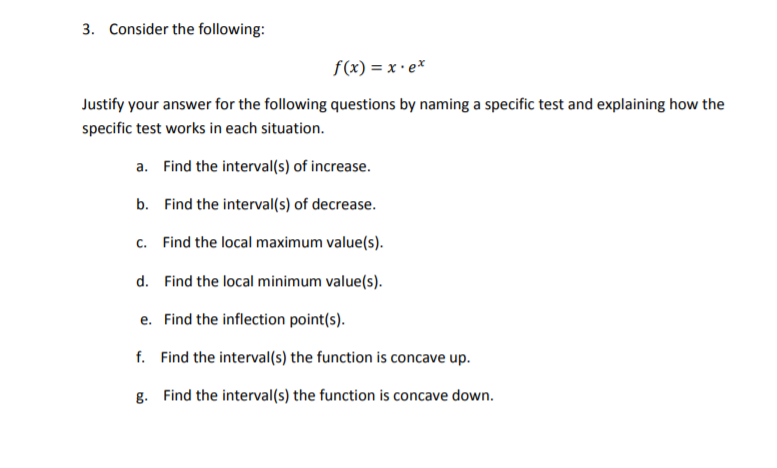3. Consider the following: f(x) = x • e* Justify your answer for the following questions by naming a specific test and explaining how the specific test works in each situation. a. Find the interval(s) of increase. b. Find the interval(s) of decrease. c. Find the local maximum value(s). d. Find the local minimum value(s). e. Find the inflection point(s). f. Find the interval(s) the function is concave up. g. Find the interval(s) the function is concave down.
3. Consider the following: f(x) = x • e* Justify your answer for the following questions by naming a specific test and explaining how the specific test works in each situation. a. Find the interval(s) of increase. b. Find the interval(s) of decrease. c. Find the local maximum value(s). d. Find the local minimum value(s). e. Find the inflection point(s). f. Find the interval(s) the function is concave up. g. Find the interval(s) the function is concave down.
Chapter3: Functions
Section: Chapter Questions
Problem 30RE: For the following exercises, use the graphs to determine the intervals on which the functions are...
Related questions
Question

Transcribed Image Text:3. Consider the following:
f(x) = x • e*
Justify your answer for the following questions by naming a specific test and explaining how the
specific test works in each situation.
a. Find the interval(s) of increase.
b. Find the interval(s) of decrease.
c. Find the local maximum value(s).
d. Find the local minimum value(s).
e. Find the inflection point(s).
f. Find the interval(s) the function is concave up.
g. Find the interval(s) the function is concave down.
Expert Solution
This question has been solved!
Explore an expertly crafted, step-by-step solution for a thorough understanding of key concepts.
This is a popular solution!
Trending now
This is a popular solution!
Step by step
Solved in 3 steps with 3 images

Recommended textbooks for you


College Algebra (MindTap Course List)
Algebra
ISBN:
9781305652231
Author:
R. David Gustafson, Jeff Hughes
Publisher:
Cengage Learning


College Algebra (MindTap Course List)
Algebra
ISBN:
9781305652231
Author:
R. David Gustafson, Jeff Hughes
Publisher:
Cengage Learning